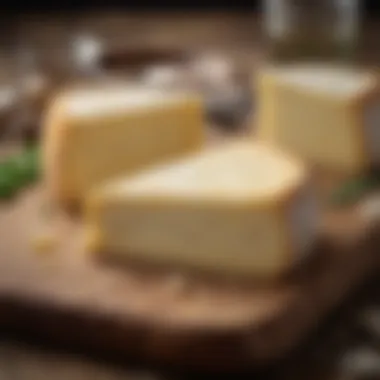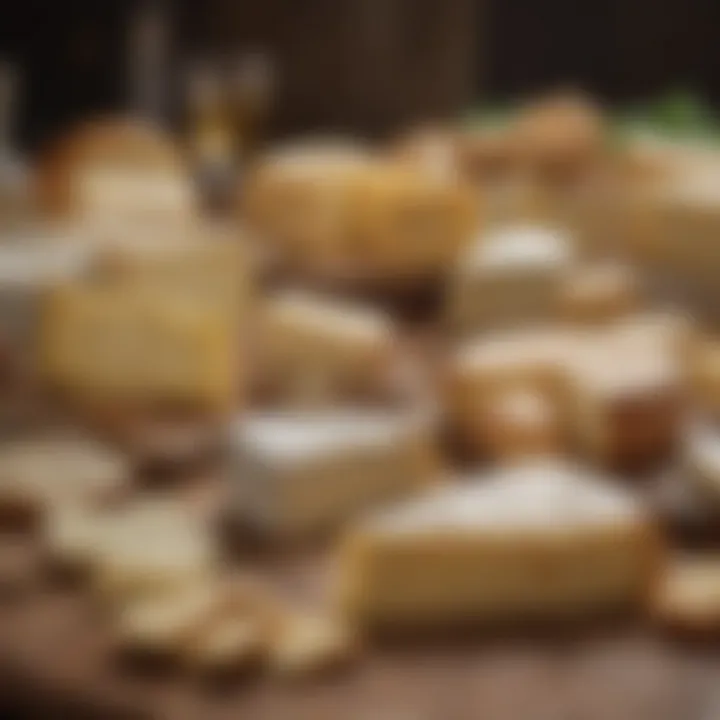Substitutes for Fontina: Culinary Alternatives Explored


Intro
Fontina cheese is celebrated in culinary circles for its distinctive creamy texture and rich flavor, making it a favorite in many printed recipes. However, its availability can often be inconsistent, prompting the need for alternatives. This guide aims to present suitable substitutes for Fontina, exploring various options to enhance culinary flexibility. By understanding the characteristics of Fontina and viable substitutes, one can elevate their recipes without sacrificing taste.
This exploration is particularly helpful for busy individuals who still want to enjoy quality meals at home. From discovering comparable cheeses to integrating non-dairy options, the information provided will help you navigate your cooking needs effectively. Let's delve into the various features and practical applications of these alternatives, ensuring you feel confident in foraging culinary variations.
Recipes Overview
- Creamy Delight Pasta Casserole
Yields: 4 portions
Prep & Cook Time: 45 minutes
Difficulty: Medium
Main Ingredients
- 300 grams of pasta
- 200 grams of alternative cheese (e.g., Gruyère)
- 250 ml of thick cream
- 1 cup of sautéed vegetables (zucchini, bell pepper)
- Herbs like oregano and basil
This dish plays to cheesy goodness while honoring the fundamental richness associated with Fontina, using umami-packed substitutes to maintain flavor integrity. At 45 minutes for prep and cook time, busy cooks can produce a savory meal with relatively little effort.
Step-by-Step Instructions
- Prep Ingredients
- Combine Cheese & Cream
- Combining All
- Baking
- Begin by cooking pasta according to package directions, ensuring it remains al dente.
- Sauté vegetables until tender in an oiled pan.
- Mix the alternative cheese and thick cream until fully blended for a creamy sauce.
- If desired, melt cheese gently while whisking to achieve a flowy texture.
- Once drained, fold cooked pasta and sautéed veggies into the cheese cream mixture.
- Ensure everything is covering thoroughly before transferring to a casserole dish.
- Sen pour into pre-heated oven for 20 minutes at 180 degrees Celsius until the top is golden.
Time-saving strategies may involve preparing some ingredients in advance, particularly the chopping of vegetables, or selecting frozen ones.
Nutritional Information
- Calories per Portion: 460
- Macronutrient Breakdown:
- Proteins: 15 grams
- Fats: 25 grams
- Carbohydrates: 45 grams
This dish boasts a healthy serving of protein from the cheese and pasta, alongside essential fats and carbohydrates, contributing to a balanced meal.
Quick Cooking Tips
- Utilizing an air fryer can present an alternative angle for cooking crispy toppings, adding flavor and crunch without extra oil.
- Multitasking can reduce overall time: put water for pasta to boil when prepping other ingredients.
- Opt for whole grain pasta instead for additional health benefits. This minor swap also supports higher fiber content.
Related Recipes & Variations
- Vegetarian Quiche: Substitute the filling with alternate cheese and seasonal vegetables, accommodating those who are plant-focused.
- Creamy Risotto: The same cheese alternatives lend creaminess to this traditional dish. Using Arborio rice allows flavors to meld smoothly.
Creating variations encourages creativity in the kitchen. Feel free to also share your takes or ideas using the comments.
A well-chosen substitute can not only replicate texture, but can often elevate a dish to new culinary heights.
Understanding Fontina Cheese
Fontina cheese is not only a unique dairy product; it represents a significant aspect of culinary tradition in regions where it is made. Recognizing the profile of Fontina is instrumental when seeking out alternatives. This section closely examines the origins, types, taste characteristics, and roles in various dishes. A thorough grasp of these aspects can make a world of difference in both cooking challenges and experimenting with flavors.
Origin and Types of Fontina
Fontina is primarily associated with two main regions: Aosta Valley in Italy and regions of Scandinavia. The Italian variety, known as Fontina Valle d'Aosta, boasts a Protected Designation of Origin status. This designation ensures that the cheese is produced on specific farms and follows traditional methods. The composition of milk typically involves cows grazing on mountain pastures, which imparts particular flavor nuances. Scandinavian versions, while sharing some similarities, might not follow the same stringent regulations. Over time, these diverse conditions lead to a range of Fontina types, each with distinct qualities catering to various culinary needs.


Flavor Profile and Texture
Fontina cheese is appreciated for its full-bodied, rich flavor, which ranges from nutty to slightly sweet, depending on its maturity. Young Fontina exhibits a creamy texture and can melt beautifully in various recipes. In contrast, aged varieties develop more pronounced flavors and a firmer structure. This meltability and robust taste make it favored in dishes such as fondue or risottos. It is important to recognize these characteristics when contemplating substitutes, as not all cheeses will maintain that uniquely pleasing combination of taste and texture.
Culinary Uses of Fontina
Fontina finds its place multiple environments, serving versatile functions in the kitchen. One of its most celebrated uses is in melting applications; cheese lovers often select it for creamy sauces and topping casseroles. It pairs well with fruits, herbs, and meats, enhancing complex flavor profiles and adding richness to many cheese boards. As such, understanding how Fontina is utilized in cooking provides insight into comparable alternatives, encouraging thoughtful experimentation with flavors and textures when it is inaccessible. The emphasis on such cooking flexibility broadens a chef or home cook's repertoire and promotes creativity in various culinary contexts.
The Need for Substitutes
In the realm of culinary creativity, the ability to adapt and modify recipes is a crucial skill. As enthusiasts strive to maintain both flavor and quality in their cooking, the search for substitutes for specific ingredients, such as Fontina cheese, becomes imperative. Fontina, known for its rich creaminess and depth of flavor, may not always be present in one's kitchen or grocery stores. Therefore, understanding the need for substitutes encourages flexibility, cost-efficiency, and overall satisfaction in cooking.
Reasons to Find Alternatives
The rationale for exploring alternatives is multi-faceted. For one, the uniqueness of Fortina may draw people in but what if that unique tastes unavailable? Having several substitutes opens up possibilities without getting stuck in limited avenues. This not only promotes resourcefulness but also enhances the growth of one’s culinary skill set.
Substituting Fontina—or any ingredient—can also reduce meal costs. In many cases, certain substitutes are less expensive. This adjustment may ultimately allow enthusiasts to enjoy flavorful dishes without a significant financial burden.
Additionally, experimenting with different cheeses can lead to a better grasp of complementary flavors and textures in various dishes, especially when it comes to layerings of taste.
Availability Issues
Fontina cheese can suffer from availability issues. This means it might not always be in stock at local markets. Various regions have different access to products. A search for a specific type, such as Val d'Aosta Fontina from Italy, may bear little success outside of specialized shops. Furthermore, seasonal variations and regional imports can add hurdles in sourcing genuine Fontina. For this reason, alternatives need to be explored to avoid disappointment during dish preparation.
Moreover, convenience plays a significant role as busy individuals may resort to local stores that feature more common and widely accessible cheeses. This adds to the reasoning behind searching for substitutes that embody similar qualities as Fontina, thus ensuring minimally invasive adjustments to the overall recipes utilized.
Dietary Restrictions and Preferences
The world of cuisine is increasingly embracing diverse dietary needs and preferences. A conscientious chef must consider many factors when choosing attributes for their dishes. With the growing prevalence of food allergies, plant-based diets, and lactose intolerance, it becomes essential to account for these variations.
For instance, someone who is lactose intolerant would look for non-dairy options to enjoy creamy sauces without discomfort. Likewise, a vegan customer may need substitutes that echo the richness of Fontina but in a completely plant-based manner. Understanding the dynamics behind dietary needs informs chefs about how to craft adaptable recipes without losing a distinctive flavor.
Embracing this scenario can expand palate possibilities and lead to innovative new dishes while respecting preferences on diet and lifestyle choices. Thus, Fontina substitutes become not just a preferable backup, but an avenue for respect to the diverse culinary landscape.
Choosing Appropriate Substitutes
Choosing appropriate substitutes for Fontina cheese is not just a matter of finding something similar. It’s about ensuring that the replacement enhances the dish without compromising on flavor or texture. For culinary enthusiasts, understanding how to select the right alternative can lead to a more enjoyable cooking experience. The nuances of flavor compatibility, texture considerations, and fat and moisture content are key elements to evaluate.
The right substitute can maintain the integrity of a recipe, while also providing the room for creative culinary exploration. Here are some factors to weigh when selecting substitutes:
- Overall flavor: Does the alternative bear a resemblance to Fontina’s rich, nutty character?
- Mouthfeel: Is the texture creamy enough to match what you desire from a Fontina experience?
- Stretchiness and melt characteristics: Especially important in dishes like mac and cheese or fondue.
Being equipped with this knowledge allows chefs to navigate their kitchens efficiently, even when they encounter an ingredient shortage. Let’s dive deeper into these elements.
Flavor Compatibility
When replacing Fontina, one of the first aspects to consider is flavor compatibility. Fontina’s profile features a semi-soft texture with a creamy, buttery undertone. A good substitute, such as Gruyère, offers a similarly rich flavor. However, Gruyère might be slightly sweeter and nuttier. Knowing these subtleties aids in striking a balance when mixing flavors.
Some substitutes bring unique characteristics that enrich a dish:
- Havarti: Mild with a slightly tangy profile.
- Emmental: Close to Fontina but more assertive in flavor.
Choosing substitutes isn’t solely about working with a shred factor; it’s best when the flavors cllaash and harmonize instead of clash. Ensure flavor layering works well in the cooking context.
Texture Considerations
Texture is often as crucial as taste. Fontina should melt beautifully; therefore, its substitutes need to possess similar qualities. Smoothness and creaminess should be non-negotiable attributes.
- Mozzarella: It melts very well but is softer. Best used when combined with others.
- Monterey Jack: Offers a firm and creamy texture, particularly useful in baked dishes.


Paying attention to how substitutes melt can make a real difference, especially in recipes where a smooth texture is crucial.
Fat and Moisture Content
The level of fat and moisture in cheese significantly impacts its cooking behavior and overall taste in dishes. Fontina boasts a higher fat content compared to many hard cheeses. A substitute with lower fat may not create the same rich mouthfeel, nor may it maintain its texture when heated.
Consider these points while making your choice:
- A high-fat cheese generally offers a creamier texture.
- Moisture content will influence melting properties.
Finding a substitute that matches Fontina in these respects can enhance the creaminess and depth of flavor without losing the dish's original inspiration. An interplay between these characteristics will deliver satisfying culinary results for any cuisine type and preference.
Remember, implementing effective substitutes promotes both culinary resilience and adaptability. Happy cooking!
Top Substitutes for Fontina
In the varied landscape of culinary practices, locating the right substitute for Fontina cheese is not only beneficial but essential for maintaining flavor integrity in dishes. Given Fontina’s rich creaminess and distinctive taste, understanding the suitable alternatives allows cooks to continue their gastronomic pursuits without missing out on quality. Choosing the right substitute can enhance meals while accommodating factors like availability, dietary preferences, or budget constraints. Below are some of the most notable substitutes for Fontina, analyzed for their unique characteristics and contributions to dishes.
Gruyère
Gruyère cheese stands out as an excellent substitute for Fontina due to its balanced flavor and meltability. Originating from Switzerland, Gruyère showcases a subtle nuttiness and a complex taste profile. Its firmness lends structure to recipes, making it ideal for gratins and fondues. When melted, it becomes deliciously creamy without losing its cohesiveness, making it possible to achieve a rich texture reminiscent of Fontina in various baked dishes. Serving Gruyère in a cheese board can also create an appealing contrast to softer cheeses. However, one should note that Gruyère possesses a stronger flavor, which might slightly alter the dish's essence, but often in a favorable way.
Emmental
Emmental cheese is another noteworthy substitute for Fontina, both for its flavor and texture. Known as a staple in Swiss cuisine, Emmental has holes throughout its structure, caused by gas bubbles during maturation. This cheese embodies a mild, slightly sweet taste that complements a range of dishes. Emmental is versatile and tends to melt well, contributing to creamy sauces or soups. Those looking for an alternative to Fontina in a raclette dish will find Emmental suits the profile quite nicely. While adding Emmental may temper the complexity associated with Fontina, it results in a lovely nutty backdrop that works wonderfully across many culinary applications.
Mozzarella
Mozzarella may not be the first cheese that comes to mind when considering substitutes for Fontina; however, it covers various culinary needs, particularly in baked items like pizzas, casseroles, or lasagnas. Fresh mozzarella provides a milder flavor but its signature stretchiness makes it a standout option, whereas low-moisture versions yield a silkier texture when melted. Notably, when adding mozzarella to dishes requiring a Fontina-like creaminess, it can unify the flavors through its inherent moisture content. Ultimately, this cheese can be a flexible player in comfort food recipes, even if the flavor is less robust than Fontina.
Havarti
Havarti is an intriguing alternative imports from Denmark and fits distinctively into the equation as a replacement for Fontina. The texture is semi-soft and displays variations in aroma and taste, often resembling a buttery profile. Havarti melts effortlessly and will meld into dishes with ease, creating that coveted creaminess while remaining relatively mild. Whether using Havarti in sauces, sandwiches, or mac and cheese, it provides a versatility that aligns nicely with Fontina's qualities. Yet, it is crucial to balance flavors, as Havarti might not fully emulate the depth found in Fontina but elevates the dish with a wholesome creaminess.
Monterey Jack
Monterey Jack pivots away toward another direction compared to traditional European cheeses but serves effectively as a Fontina substitute in numerous dishes. Its mild, buttery taste and smooth texture make it an approachable option, expediting its incorporation into myriad recipes. Monterey Jack's melting characteristics particularly shine in casseroles, quesadillas, and any culinary activity that demands creamy cheese. With variations like Pepper Jack adding a spicy twist, there is room for exploration here. Overall, Monterey Jack becomes a friendly alternative, allowing home cooks to enjoy a responsive cooking time without compromising on enjoyment.
Creative Uses for Substitute Cheeses
Exploring substitute cheeses extends beyond mere replacements in recipes; it opens doors to creative culinary uses that enhance flavors and textures. The ability to skillfully incorporate these alternatives can elevate dishes, providing richness comparable to that of Fontina. By understanding how and where to apply these cheeses, culinary enthusiasts can ensure versatility in their cooking.
In Baked Dishes
Substituting cheeses like Gruyère or Havarti in baked dishes can yield great results. These cheeses melt impressively, maintaining a creamy consistency that complements various recipes. For instance, when making a cheesy pasta bake, Havarti’s creaminess can enrich the sauce, while Gruyère adds a nutty finish.
Here are a few considerations:
- Meltability: Look for cheeses that allow for smooth melting without separating.
- Flavor Correlation: Choose substitutes that possess flavor profiles similar to Fontina. This brings cohesion to the meal.
- Browning Quality: Certain cheeses, like Gruyère, work well to create a beautiful golden crust.
In Sauces and Soups
Substituting fontina in sauces and soups can enhance the overall creaminess without losing the characteristic rich flavor.
For creamy sauces:
- Emmental acts as a suitable option that can keep the sauce smooth. Its mild taste can be complemented with spices or herbs.
- Mozzarella, while known mostly for its stretching quality, can contribute a soft texture. When blended into a sauce, it emulsifies well without altering the taste significantly.
For soups:


- Incorporating Monterey Jack can serve to create that velvety texture. When stirred in at the end of cooking, it can lend a delightful cheese flavor.
In Cheese Boards
Cheese boards serve as a fantastic avenue to showcase the beauty of alternative cheeses. Laying out a selection that visually and texturally intrigues will draw interest.
- Building a Board: Choose cheeses that vary in firmness, flavor, and color. A mix of Gruyère, Havarti, and Manchego can offer diverse experiences.
- Consider Pairings: Most substitutes can pair well with fruits, nuts, or spreads. Choosing complementary flavors can enhance appreciation of the substitutes.
- Presentation Matters: Slice different kinds of substitute cheese; pairing them alongside a soft cheese can create pleasing contrasts.
A well-assembled cheese board can become an artistic endeavor, showcasing how substitutes can delight the palate.
By acknowledging these culinary applications, enthusiasts can unlock creative potentials within their kitchens. Substitutes for Fontina need not merely act as backup; with mindfulness to their uniqueness, they can perform remarkably well in different settings.
Copying Fontina’s Characteristics
When considering substitutes for Fontina cheese, it is essential to be mindful of what makes this cheese distinct. This section focuses on how to replicate two primary characteristics of Fontina: creaminess and flavor depth. Understanding these traits will help culinary enthusiasts select proper alternatives that do not compromise the overall quality of their dishes.
Mimicking Creaminess
Creaminess is one of the defining traits of Fontina cheese. This attribute not only enriches the mouthfeel of the dish but also enhances the absorption of flavors. To achieve similar creaminess with substitute cheeses, some strategies can be put in place.
You might want to consider cheeses like Havarti or Gruyère. Havarti, known for its buttery texture, often smooth is ideal. Gruyère, while it possesses a firmer texture, can still dissolve nicely in warm dishes, providing that creamy indulgence iconic to Fontina.
Additionally, integrating fats can also promote creaminess. Adding heavy cream or even a mix of cream cheese with your choice cheese is a practical method to mimic Fontina’s character. Using these ingredients allows for richness and maintains vibrancy in flavored dishes.
Some tips for achieving a creamy texture include:
- Melting: Make sure to choose cheeses that melt well under heat.
- Fat content: Supervising the exact percentages of fats, ensuring they are sufficient to produce a creamy mouthfeel.
- Blending with additional creams: Using other elements like heavy cream or mascarpone can bridge the gap significantly.
"The creamy consistency not only adds luxe layer to dishes but elevates overall taste enjoyment."
Achieving Flavor Depth
Now, moving on to flavor depth, it is critical to understand that Fontina offers a unique, complex taste profile that features nutty, buttery, and sometimes mildly pungent elements. Imitating this flavor complexity in substitutes demands a holistic approach.
Cheeses such as Gruyère also excel in bringing depth. Gruyère has a stronger flavor profile combined with subtle sweetness, adding another layer of sophistication when used in cooking. If these choices prove less accessible, consider mixing younger cheeses with a sprinkle of Parmesan or even some aged cheddar to amplify richness further.
Using herbs and spices can complement the flavors of your substitute. For instance, incorporating thyme or nutmeg can elevate each bite, making up for the lack of interest that some substitutes may offer on their own.
Essential consideration for maximizing flavor similarities include:
- Choosing higher quality substitutes: It’s obvious that fresher, aged, or artisanal varieties keep flavor richer.
- Layering flavors through cooking methods: Roasting or baking can enhance flavors but ensure solid matching throughout the cooking methods used.
- Use acidity with caution: Balancing acid from elements like lemon zest or vinegar may create a counterbalance thus enriching your dish overall.
Mimicking the quintessential features of Fontina is not just about swapping one cheese for another; it's about understanding how aspects like creaminess and flavor depth influenced the dish. By tailoring substitutes based on these characteristics, any cook can achieve satisfactory results in their savory creations, ultimately leading to satisfactorily delightful exceptions.
The End
In the exploration of culinary substitutes for Fontina cheese, understanding the options available becomes crucial. Replacing a fundamental ingredient like Fontina can seem daunting, especially given its unique attributes. However, making an informed decision regarding substitutes can lead not only to successful meal preparation but also to enhanced dishes that offer the same creamy texture and rich flavor. By recognizing the available alternatives, you take steps to maintain the desired characteristics compared to Fontina while still managing your dietary needs, ingredient availability, or personal preferences.
Evaluating Your Options
When evaluating your options for substituting Fontina cheese, several factors must come into play. Firstly, consider the dish at hand. Some recipes may require a stronger or milder flavor, and correct matching of these characteristics is key to achieving satisfactory results. Secondly, pay attention to the texture, especially in baked dishes or sauces. The alternative cheese’s ability to melt smoothly and integrate well is vital for the final quality of the dish. Thirdly, the fat content can change the consistence and mouthfeel. Choosing cheeses with similar fat profiles ensures that you don't sacrifice richness for dietary needs.
Here are some points for consideration:
- Recipe requirements: Determining how essential Fontina's specific taste and meltability are to your dish helps in selecting a worthy replacement.
- Personal taste: Include options that align closely with your flavor preferences.
- Dietary restrictions: Some substitutes content dairy or lactose and may Not be suitable for everyone.
- Availability locally: Check the local market or online stores for specific cheeses like Gruyère or Emmental before making any definite choices.
"Selecting the right substitute allows for culinary creativity without compromising the overall flavor profile or texture your dish demands."
Encouraging Culinary Experimentation
Encouraging culinary experimentation is essential to fostering creativity in the kitchen. While substitutes may seem primarily focusing on imitating Fontina, they offer opportunities to broaden one’s culinary palate. Trying different cheeses can lead to unexpected discoveries about flavor compatibility and new combinations that work excellently together. Consider blending a couple of substitutes rather than relying solely on one—for instance, mixing Havarti with a bit of Gruyère can create a rich, nuanced flavor.
Engagement in this kind of exploratory cooking grants the freedom to modify and develop recipes pressed by your personal touch or inspiration from global cultures. Incorporating bold cheeses from far-flung regions may become part of daily specials or components dear to your heart, giving them meaningful personal contexts.
Experiment effectively by noting outcomes for various substitutions and their role in enhancing or altering prescribed recipes, allowing you to build a personal guide tailored for your cooking style over time. Thus, focus on creativity without constraints and make the kitchen a laboratory of flavor. Find what works for you and perhaps share your culinary findings within communities like redd.it where fellow food enthusiasts may appreciate your creative journeys!







